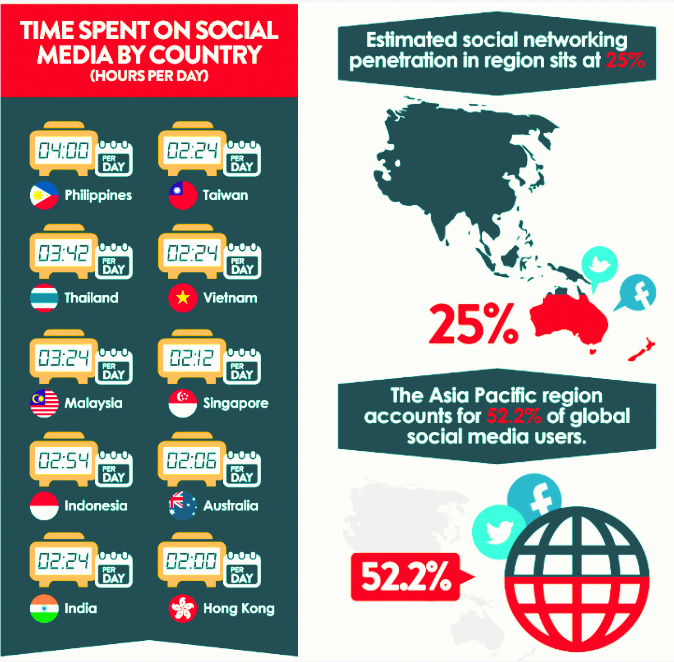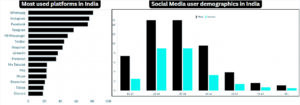
As of October 2023, the global user base for social media has exceeded 4.95 billion, and on average, each user engages with 6.7 social media platforms per month. Notably, widely used platforms such as Facebook witness a daily login rate of over 68.38% among their monthly user base.

It’s worth noting that social networks commonly provide growth data based on monthly active users (MAUs) rather than the number of accounts, as this metric offers a more accurate reflection of real usage and territorial reach.
The utilization of social media is pervasive across Asia, with the Asia-Pacific (APAC) region comprising approximately 60% of the total global social media user base as of 2023. Projections suggest a consistent annual growth rate of 2.7% for this region, indicating an anticipated influx of over 59 million new users in 2024.
Facebook and X enjoy widespread recognition in certain countries, yet numerous popular social media platforms remain unfamiliar to Western audiences.
As of January 2023, Brunei emerged with the highest active social media user penetration in the Asia-Pacific region, boasting an impressive rate of 94.4 per cent. Following closely, South Korea secured the second position with a noteworthy penetration rate of 92 per cent.
In contrast, Indonesia exhibited a social media penetration rate of 60.4 per cent, showcasing a distinctive variance in the adoption and engagement levels across these nations in the region.
Social media in APAC
Despite Taiwan, Singapore, and Malaysia boasting relatively high social media penetration rates, a distinct narrative emerges when considering the number of monthly active mobile social media users in the Asia-Pacific region. China emerges as a dominant force, surpassing the one billion mark in terms of users accessing online services through mobile devices.
This significant figure far exceeds the user count of the second-placed country, India. South Korea reported 43.04 million social media users, showcasing a notable presence but considerably less than China.
Meanwhile, Singapore recorded a more modest user base, with only 4.3 million social media users during the same period in the Asia-Pacific region.
What are the most popular social networks?
Facebook stands out with an astronomical number of monthly active users in the Asia-Pacific region, solidifying its position as a top choice among social media users in this vast area.
Despite the popularity of global platforms such as Instagram, Twitter, Snapchat, and YouTube across the region, it’s noteworthy that locally developed Asian platforms also enjoy significant favour and engagement among social media users. This underscores the dynamic and diverse social media landscape in the Asia-Pacific region, where both global and regional platforms coexist and thrive.
Established in 2005, QZone stands as a prominent social networking site rooted in China. Offering a range of services such as instant messaging and engaging video games, including popular titles like League of Legends and World of Fantasy, QZone has become an integral part of the Chinese social media landscape.
Additionally, Japan’s LINE has proven to be another widely embraced social media platform, experiencing a continuous growth trajectory with the number of LINE users in Japan set to rise annually. These platforms exemplify the diversity and appeal of locally developed social media networks in the Asian digital sphere.
India boasts a substantial social media landscape, with 467 million users, constituting approximately 32.8% of the population. An overwhelming 99.5% of these users access social media through their mobile phones. Facebook, YouTube, WhatsApp, and Instagram emerge as some of the most popular platforms in the country, with LinkedIn also holding a robust presence, counting over 99 million members among its users.
Notably, in 2023, India claimed the highest number of Facebook users globally, totalling 314.6 million users.
However, the social media landscape in India underwent a significant shift on June 29, 2020, when the Ministry of Electronics and Information Technology imposed a comprehensive ban on TikTok and 58 other apps of Chinese origin.
The ban was justified on grounds of potential threats to the country’s sovereignty, integrity, defence, security, and public order. This regulatory move marked a notable development in India’s approach to digital platforms with international origins.
In India, WhatsApp stands as the social media platform with the largest user base, closely trailed by other Meta-owned platforms like Instagram and Facebook, as per 2022 data. WhatsApp has emerged as the primary communication mode for many Indian citizens. However, a sizable user base does not necessarily equate to the frequency of usage.
According to a recent consumer sentiment survey conducted by AXIS My India in January 2023, 35% of users identified Facebook as their most frequently used social media platform, marking the highest preference in the country.
The platform’s prominence increased during the pandemic when strict social distancing measures prevented India’s massive population of 1.3 billion from engaging in person, prompting a significant shift to digital channels, particularly WhatsApp, to maintain connections with friends and family.
This behavioural change is also reflected in the search interest, measured by Google Trends, which indicated that WhatsApp surpassed Facebook in mid-2021 in terms of user queries and engagement.
In India, WhatsApp’s dominance remains unparalleled, with no discernible competitors on the horizon. The introduction of WhatsApp Business, coupled with ongoing improvements to its commerce features, has spurred numerous business owners to embrace the platform as their primary tool for managing customer relationships.
In conclusion, the APAC region, comprising 60% of global social media users, exhibits significant diversity in platform popularity among its countries, reflecting unique user behaviours and preferences.
Overall, the social media landscape is a dynamic interplay of global giants and locally developed platforms, reflecting the diverse preferences and behaviours of users across different regions. The continuous evolution of social media platforms and their impact on communication, connectivity, and commerce underscores their integral role in shaping digital trends worldwide.